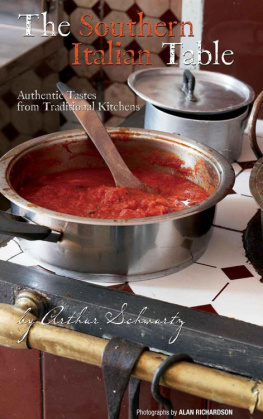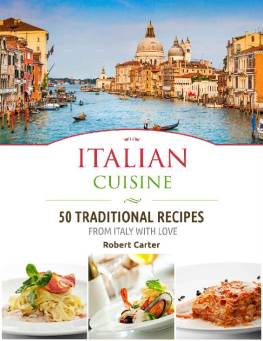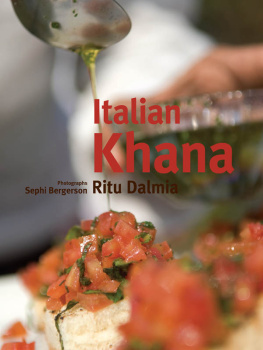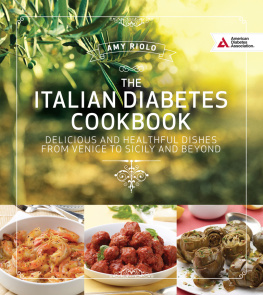The Southern Italian Table
Authentic Tastes
from Traditional Kitchens
by Arthur Schwartz
Photographs by Alan Richardson
Table of Contents
For Cecilia Baratta,
Baronessa Bellelli
Copyright 2009 by Arthur Schwartz
Photographs copyright 2008 by Alan Richardson
All rights reserved.
Hardcover book published in the United States by Clarkson Potter/Publishers
Digital book published by the author, Arthur Schwartz
Digital design by Roger Dapiran
ISBN 978-0-692-29236-5
Introduction
My affinity for Southern Italy comes naturally, even though my name is Schwartz. I grew up among Italian Americans in Brooklyn, New York, where, starting in the early 1920s, mostly Jewish, Irish, and Southern Italian immigrants moved from the tenement slums of Manhattan to working-class and middle-class homes and apartments in the citys outer boroughs. I was weaned on ziti with rag by our Neapolitan downstairs neighbors. You might say I was a second-generation Italian-American adoptee. My father also grew up in a two-family house in Brooklyn with a Southern Italian family downstairs. When we visited my grandparents in his childhood home on Sundays, their house was filled with the aroma of Anna Nicotras Sunday gravy and the perfume of her husband Jerrys (Gennaros) wine in the basement.
It may have been the food of my neighbors that first drew me to the south of Italy, especially to Naples, but I also loved that south of Rome the country often felt like the prewar Europe that was quickly becoming Americanized. Youve got to do something between meals, and the south turns out to have more art, beautiful architecture, and important archaeological ruinsgorgeous stuff to see, inspire, and enlightenthan one could absorb in a lifetime.
Southern Italy is a land of drama and contradictions. It has great expanses of unspoiled physical beauty, arid stretches and heroically fertile ones. It has urban slums and hundreds of miles of white sandy beaches. Its people are earthy, often farmers or others who depend on the land for their living, but just as frequently they have advanced educations and live professional, middle-class lives in neat homes and apartments where the kitchen is still the center of life and the table is where everyone meets, even when dressed in Armani and Prada.
There are hillsides and valleys checkerboarded with the matte gray of olive trees and the shiny deep green of citrus. There are high mountains covered with evergreens and deciduous trees that turn red and gold in the fall. On the forest floors grow an amazing number of mushrooms. There are cliffs that end in the sea, cities whose streets are lined with palm trees, ancient hill towns that nearly make you cry with their decrepit beauty, and modern towns built with the lack of zoning and poor construction that new money, old corruption, and the notorious criminals of Southern Italy amply provide.
Travel posters used to call it Sunny Italy. Italians call it the Mezzogiorno, literally meaning midday, referring to the plentiful, sometimes relentless sun. It is also known as the Meridionale. The stereotype of the peopleby Northern Italians, other Europeans, and non-Italians in places around the world where Southern Italians have emigratedis that they are shiftless and carefree, dancing tarantellas under the moonlight, singing love ballads, playing the mandolin on the backs of donkeys. They shout. They argue. They are vulgar. They connive. They are hard-headed, dark-skinned, and dark-eyed.
What you may not hear is that Southern Italians are warm-hearted, welcoming and generous, loyal and kind, with a deep sense of humanity and the conviction that were all in this together, rich and poor, educated and not. In Southern Italy it is easy to make friends. I had no trouble wheedling my way into other peoples lives and kitchens, to peek into their pots and be invited to eat at their tables with their friends and family, which is what food journalists like to do best.
Southern Italians are so proud that the Greeks arrived near Naples as early as 800 bce, bringing an advanced civilization, that there is a joke about it: When northerners were still painting themselves blue and hanging from the trees, we were already gay.
The Greeks came to trade with the Iron Age Etruscans, locals whose settlements came as far south as where Naples is today. There were other native Italic peoples on the southern half of the peninsula, too. The Samnites and Oscans were in Campania and Molise. The Brutti and -Lucanians were in what is now Basilicata. The Daunii inhabited what is now southern -Molise and northern Puglia, and the Messapii were in southern Puglia, in what is now called the Salento Peninsula. Finally, Sicily had the Siculi.
But the Greeks soon had settlements almost everywhere and Hellenized the local populations. Southern Italy became Magna Grecia, Greater Greece. The Greeks built many cities, from Naples down through Calabria, into Puglia, and of course in Sicily, the largest island in the Mediterranean, which was sought after then for its fertile soil, as well as its strategic position. The nearly landlocked and mountainous Basilicata was the only place on which the Greeks did not exert a grip.
Many of the Greeks temples and the remnants of their cities are still standing, a testament to their astounding construction talents. Among them are three fifth- and sixth-century bce Doric examples in Paestum, looking very grand along a modern local byway called Via Magna Grecia, on the plain of the Sele River, just south of Salerno and the Amalfi Coast, about a mile down the road from where, for the last decade, I have been conducting cooking classes and culinary-cultural tours with Baronessa Cecilia Bellelli Baratta. Our home base and our kitchen classroom are on her two farms, Azienda Seliano and Masseria Eliseo, which she operates with her two sons, Ettore and Massimino Bellelli. On one, Eliseo, the Bellelli family raise water buffalo, the largest herd in the province of Salerno (about 900 head), while on the other, Seliano, they grow grain and grasses for the buffalo to eat and have guest rooms appointed with vintage furniture, a swimming pool in a garden, and a huge dining room and giant gazebo where guests dine. A staff of local women prepares the guests meals and caters large partiesweddings, christenings, first communions, and the like. You will meet all my Seliano kitchen friends in this book. I have been cooking with them for twelve years and they have taught me much.
Cecilia is the organizer of our school and the excursions we are always changing, while I am in the kitchen with the students and their tour guide outside it. But Cecilia is a very good cook and her recipes are here, too. And did I mention that she is a walking encyclopedia of Italian foodways and food products, northern and southern, and that she is fluent in English and French? She has made Azienda Seliano so comfortable, elegantand quirky!that it is listed in many guidebooks, including 1,000 Places to Visit Before You Die.
Together with my spouse, Bob Harned, an archaeologist, and our friend Nicolas Claes, who is Belgian but has been living in his own apartment at Seliano for eighteen years, and frequently Iris Carulli, my former personal assistant, an art historian, and guide who now lives in Rome, and is one of the best cooks I know, I have traveled to every province of every southern region: Campania, Molise, Basilicata, Calabria, Puglia, and Sicily. Most of the recipes in this book have been collected on these trips, then developed and tested with American ingredients in my small apartment kitchen in New York City.









